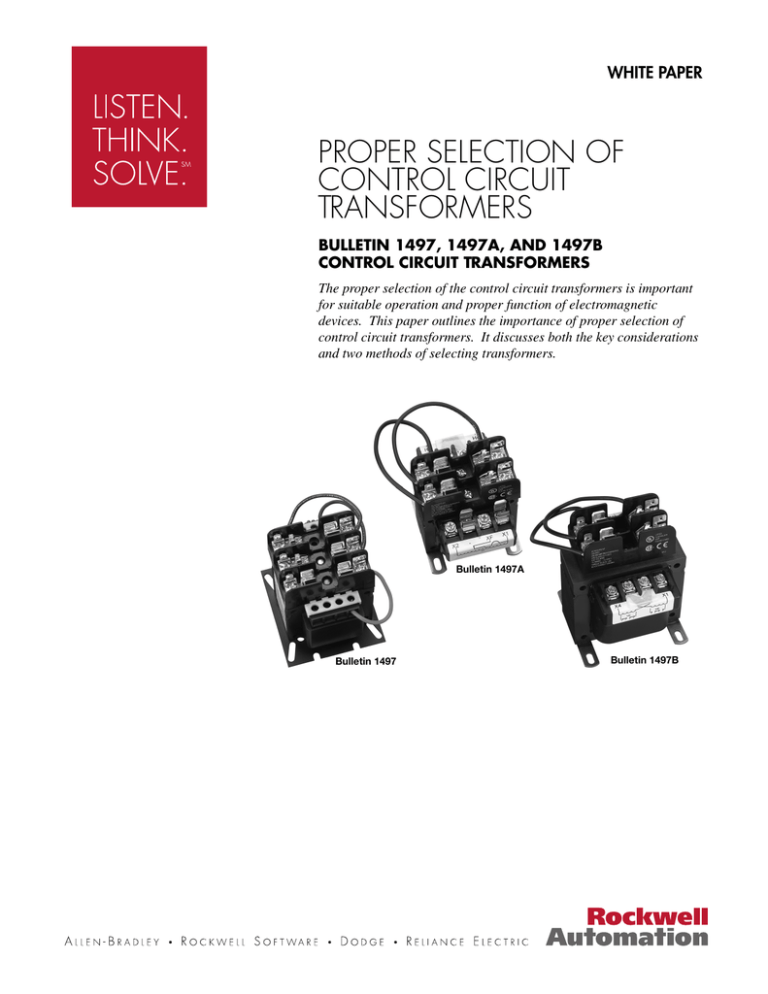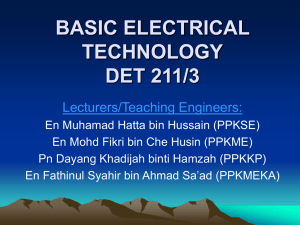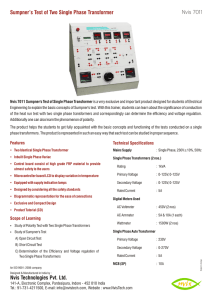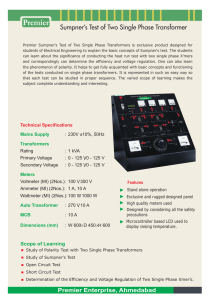
WHITE PAPER
PROPER SELECTION OF
CONTROL CIRCUIT
TRANSFORMERS
BULLETIN 1497, 1497A, AND 1497B
CONTROL CIRCUIT TRANSFORMERS
The proper selection of the control circuit transformers is important
for suitable operation and proper function of electromagnetic
devices. This paper outlines the importance of proper selection of
control circuit transformers. It discusses both the key considerations
and two methods of selecting transformers.
Bulletin 1497A
Bulletin 1497
Bulletin 1497B
Bulletin 1497 Control Circuit Transformers
2
Bulletin 1497 Control Circuit Transformers
Table of
Contents
What is a Control Circuit Transformer? . . . . . . . . . . . . . . . . . . . . . . . . . . . . . . . . . . . . . 4
Inrush Volt-Ampere and Sealed Volt-Ampere Considerations . . . . . . . . . . . . . . . . . 4
Secondary Voltage Considerations . . . . . . . . . . . . . . . . . . . . . . . . . . . . . . . . . . . . . . . . 5
600V Primary Device Considerations . . . . . . . . . . . . . . . . . . . . . . . . . . . . . . . . . . . . . . . 5
Long Wire Runs Considerations . . . . . . . . . . . . . . . . . . . . . . . . . . . . . . . . . . . . . . . . . . . 6
Control Circuit Transformer Selection Methods . . . . . . . . . . . . . . . . . . . . . . . . . . . . . 6
Method I: Short and Conservative Means of Selecting Control Circuit Transformers . 6
Method II: Detailed Procedure of Selecting Control Circuit Transformers . . . . . . . . . . 7
European Common Market Considerations . . . . . . . . . . . . . . . . . . . . . . . . . . . . . . . . 12
Summary . . . . . . . . . . . . . . . . . . . . . . . . . . . . . . . . . . . . . . . . . . . . . . . . . . . . . . . . . . . . . . 13
33
Bulletin 1497 Control Circuit Transformers
What is a
Control Circuit
Transformer?
A control circuit transformer is a device designed to provide a reduced control voltage for
energizing the coils of electromagnetic devices such as motor starters, contactors, relays,
and timers. These devices make up the majority of the loads supplied by the control circuit
transformer. Control circuit transformers are also referred to as Industrial Control
Transformers, Machine Tool Transformers, and Control Power Transformers.
Inrush
Volt-Ampere
and Sealed
Volt-Ampere
Considerations
The proper size, or the VA rating, of the control circuit transformer is important. It will be a
determining factor in the life of the transformer, which ultimately will reflect on the proper
operation of control devices that it supplies. The methods of selecting transformer VA
ratings addressed in this technical paper are applicable to 50…3000 VA control circuit
transformers.
The transformers used in this application fall into the dry type insulation category. Typical
primary voltages in the United States are 600, 480, 240, and 208. Transformers can also be
manufactured with special primary and secondary voltage combinations.
There are two VA values to be considered when selecting a transformer. Energizing
electromagnetic components creates a large momentary surge current, commonly referred
to as inrush VA. This is the first VA value to be considered. The inrush VA will last
approximately 5…20 milliseconds and can have a value as high as ten times the
transformer's nameplate rating. Thus, the inrush VA will be high in value and short in
duration. A properly selected control circuit transformer is designed to handle the
momentary inrush VA and at the same time maintain a secondary voltage within a set
range.
The second value to be considered is the sealed VA, the amount of volt-amperes required
to maintain the energized state of an electromagnetic device. This VA requirement will be
5…10 times less than the inrush VA.
In the United States, compliance with NEMA Standard ICS 2-110 is another important
consideration. The NEMA Standard requires the alternating current contactor to
successfully close at 85% of its coil rated voltage. For example, an alternating current
contactor with 120 volt rated coil must be able to successfully close at 102 volts which is
85% of its rated voltage.
4
Bulletin 1497 Control Circuit Transformers
When a transformer is used with a contactor or starter, the contactor or starter must
successfully pick-up at 90% of the rated line voltage of the transformer. The purpose of this
NEMA Standard requirement is to:
1. Establish a standard or policy for the operation of the control device.
2. Coordinate values for the control device and the control circuit transformer.
3. Set known limits to address the inherent transformer voltage drop due to the inrush current
from an unsealed alternating current electromagnet.
For example, a transformer with a rated line voltage of 480 volts, a rated secondary voltage of
120 volts, and an operating voltage at 90% of the line voltage would have 432 volts on the
primary of the transformer. This would result in a theoretical 108 volts on the secondary, based
on the turns-ratio, assuming no voltage drop through the transformer. Properly selected
transformers must limit the voltage drop under inrush conditions such that 95% of the rated
secondary voltage occurs with 100% of the rated line voltage applied. Combining these two
conditions result in a secondary voltage of approximately 102 volts which meets the contactor
pick-up requirement.
Secondary
Voltage
Considerations
The secondary voltage that is present when a light load or no load is attached to the
transformer should also be considered. Open circuit secondary voltages (no load) can be 10%
higher than nominal with nominal input voltages applied. This means that a 480…120 volt
transformer with full 480 volts applied to the primary, can have 132 volts available at the
secondary terminals. When you add the effect of high line input condition (528 volts) to this
output, the secondary can reach over 145 volts. This is a worst case condition, but not out of
the question. This makes it even more important to size the transformer correctly for the
application and understand that the secondary voltage is designed to be nominal rated voltage
when loaded to the nameplate VA. Oversizing the transformer only serves to make this
condition worse.
600V Primary
Device
Considerations
The Allen-Bradley Bulletin 1497, 1497A, and 1497B transformer product line includes primary
voltage ratings that span from 115…600V AC. Special design attention has been applied to the
575…600V AC designs to address the potential failure of 600V units when exposed to line
aberrations or events such as surges and spikes frequently caused by switched capacitor banks
or the connection of certain types of electrical equipment, such as welders and plating
equipment, to the circuit.
In general, standard transformer construction for a 600V AC primary design tends to be more
susceptible to these problems than lower primary designs. Allen-Bradley Bulletin 1497, 1497A,
and 1497B 600V units have been strengthened in terms of insulating materials and winding
separation to provide a robust product capable of withstanding all but the most severe of these
frequently encountered line conditions.
55
Bulletin 1497 Control Circuit Transformers
Long Wire Runs
Considerations
Another consideration in the selection of the transformer is long wire runs. These occur if
the control devices requiring power are located away from the transformer. When a long
wire run is present, the resistance and capacitance cause a voltage drop to the control
device. If the voltage drop is severe enough, the control device may not pick-up. To
address this, the transformer must be selected taking this voltage drop into account. An
interposing relay may also be required. Voltage drop calculators are available from
numerous internet sites.
Control Circuit
Transformer
Selection
Methods
Method I: Short and Conservative Means of Selecting Control
Circuit Transformers
Method 1 provides a short and conservative means that will yield a sufficiently sized
transformer. Assuming that all control devices, including the transformer, are located
within the same unit, the steps are as follows:
1. Calculate the total sealed volt-ampere burdens of all the devices that could be sealed
at any one time;
2. Multiply the value from Step 1 by 1.25;
3. Calculate the maximum inrush volt-amperes of the closing device or devices;
4. Add the maximum inrush volt-amperes of closing device or devices calculated in
Step 3 to the required sealed VA calculated in Step 2;
5. Divide the maximum VA calculated in Step 4 by 4.
Using the larger of the two values calculated in Steps 2 and 5, select a transformer whose
VA rating is:
•
Closest to, but not lower than, the larger calculated value; and
•
Greater than the total sealed VA requirement
The above method of selecting a transformer is only applicable to Allen-Bradley Bulletin
1497, 1497A, and 1497B control circuit transformers. Many standard transformers from
other manufacturers are built to different manufacturing standards and have higher losses
(lower output voltage) and thus, would require larger VA ratings than calculated by this
method.
6
Bulletin 1497 Control Circuit Transformers
Method II: Detailed Procedure of Selecting Control Circuit
Transformers
Method 2 is a detailed procedure of selecting a control circuit transformer for a single relay or
contactor and is important when other considerations are required, such as, high operating
temperatures and long wire runs. When using this method of selection, technical data such as
load operating temperature, frequency, impedance, reactance and resistance may be needed
for load devices. However, this type of data is proprietary for many manufacturers. The
specific transformer application will determine the data actually needed for proper selection of
a control circuit transformer.
Transformer regulation curves are required for proper selection of transformers. Each
transformer has a regulation curve for different power factors. The complete family of
transformer regulation curves, which are available from the manufacturer, may be necessary to
select the proper transformer. Examples of transformer regulation curves are shown in Figure 1.
Figure 1. Transformer Regulation Curves
In order to determine if the size or VA rating of a particular transformer is acceptable, an inrush
impedance load line for the load must be calculated and then plotted on the transformer
regulation curves. The power factor of the load must also be determined. The point where the
load's power factor curve intersects the impedance load line is needed to determine if the
percent rated secondary voltage of the particular transformer is acceptable. If not, the
procedure is repeated using the regulation curves of a different VA rated transformer.
Allen-Bradley Bulletin 1497, 1497A and 1497B transformers properly applied will provide the
85% minimum secondary voltage per NEMA standards with 90% of the rated voltage on the
primary. As discussed earlier, this condition is met if under inrush conditions the secondary
voltage is not allowed to drop below 95% of its rating with 100% of the rated voltage on the
primary.
77
Bulletin 1497 Control Circuit Transformers
The following example (Figure 2) uses the Allen-Bradley Bulletin 1497 75VA transformer
regulation curves.
Figure 2. Allen-Bradley Bulletin 1497 75VA Transformer Regulation Curves
Given: Load = Allen-Bradley Bulletin 509 Size 1 starter
Assume: Cold coil resistance = 53.4Ω @ 20°C
Inrush VA = 192
Coil rated voltage = 120V @ 60 Hz
Calculations:
Starter inrush current @ 100% secondary voltage (II):
II = VAInrush ÷ VSec
= 192 ÷ 120
= 1.6A
Impedance of load @ 20°C (Z):
Z = VSec ÷ II
= 120 ÷ 1.6
= 75Ω
Reactance of load @ 20°C (X):
X = (Z2 - R2)1/2
= ((75)2 - (53.4)2)1/2
= 52.67Ω
8
Bulletin 1497 Control Circuit Transformers
Percent power factor of load @ 20°C (PF):
PF = (R ÷ Z) × 100
= (53.4 ÷ 75) × 100
= 71.2%
The impedance load line, to be calculated, must intersect the 75VA transformer regulation
curve at the calculated power factor of 71.2%, and at 95% of rated secondary voltage in order
to be acceptable. Two points are calculated to establish the impedance load line.
Rated secondary current (ISec):
ISec = VA ÷ VSec
= 75 ÷ 120
= 0.625 A
Percent rated secondary current @ 100% secondary voltage (%ISec):
%ISec = (II ÷ ISec) × 100
= 1.6 ÷ 0.625 × 100
= 256%
At 100% rated secondary voltage the percent rated secondary current is equal to 256%. This
data locates the upper point of the impedance load line.
Starter inrush current @ 70% secondary voltage (II1):
II1 = II × .7
= 1.6 × .7
= 1.12 A
Percent rated secondary current @ 70% secondary voltage (%ISec1):
ISec1 = (II1 ÷ ISec) × 100
= (1.12 ÷ 0.625) × 100
= 179.2%
At 70% rated secondary voltage the percent rated secondary current is equal to 179.2%. This
data locates the lower point of the impedance load line.
Draw the load line between these points.
99
Bulletin 1497 Control Circuit Transformers
Referring to Figure 3, locate the 71.2% inrush power factor on the load line, by
interpolating between the regulation curves. This point can be read on the vertical axis, as
the transformer's rated secondary voltage (in %) occurring during inrush. It should be 95%
or higher. In this example, it is approximately 95.5 percent, and the application is
acceptable.
Figure 3.
However, if this starter was operated after its coil had reached operating temperature or
was operated in a jogging or plugging application, the calculations would have to take into
consideration the elevated coil temperature.
Using the data from the previous example and the additional data following, the
calculations would be as follows:
Assume: Hot coil operating temperature = 110°C
Calculations:
Coil resistance at 110°C (R):
R
= ((234.5 + T2) ÷ (234.5 + T1)) × R@20°C
= (344.5 ÷ 259.5) × 53.4
= 70.9Ω
Reactance of load @ 110°C (X):
X
10
= X@20°C
= 52.67Ω
Bulletin 1497 Control Circuit Transformers
Impedance of load @ 110°C (Z):
Z
= (X2 + R2)1/2
= ((52.67)2 + (70.9)2)1/2
= 88.3Ω
Starter inrush current @ 100% secondary voltage @ 110°C (II2):
II2 = VSec ÷ Z
= 120 ÷ 88.3
= 1.36A
Percent power factor of load @ 110°C (PF):
PF = (R ÷ Z) × 100
= (70.9 ÷ 88.3) × 100
= 80.3%
The impedance load line, to be calculated, must intersect the 75VA transformer regulation
curve at the calculated power factor of 80.3% and at 95% of the rated secondary voltage in
order to be acceptable. Two points are calculated to establish the impedance load line.
Percent rated secondary current @ 100% secondary voltage @ 110°C (%ISec2):
%ISec2 = (II2 ÷ ISec) × 100
= 1.36 ÷ .625 × 100
= 217.6%
At 100% rated secondary voltage, the percent rated secondary current is equal to 217.6%. This
data locates the upper point of the impedance load line.
Starter inrush current @ 70% secondary voltage @ 110°C (II3):
II3 = II2 × .7
= 1.36 × .7
= 0.95A
Percent rated secondary current @ 70% secondary voltage @ 110°C (%ISec3):
%ISec3 = (II3 ÷ ISec) × 100
= .95 ÷ .625 × 100
= 152%
At 70% rated secondary voltage at 110°C, the percent rated secondary current is equal to
152%.
1111
Bulletin 1497 Control Circuit Transformers
This data locates the lower point of the impedance load line.
Draw the load line between these points.
Referring to Figure 4, locate the 80.3% inrush power factor on the load line by interpolating
between the regulation curves. This point can be read on the vertical axis as the
transformer's rated secondary voltage (in %) occurring during inrush. It should be 95% or
higher. Note that in this application the percent rated secondary voltage is approximately
96%, taking into account the power factor shift and increase in operating temperature.
Again, this application, using the 75VA control transformer, is acceptable.
Figure 4.
European
Common Market
Considerations
The requirements for industrial control circuit transformers to be used in the European
Common Market are identified by the International Electrotechnical Commission (IEC) and
specified under EN61558, non-short-circuit-proof isolating transformers, under the Low
Voltage Directive 73/23/EEC. Manufacturers of control circuit transformers indicate
compliance with these requirements by placing a CE mark on the product. The EN61558-2
standard replaces the previous EN60742 standard. The EN60742 standard expired
December 31, 2003. However, some manufacturers still carry the CE mark based on the
expired EN60742 standard. Thus, care should be taken when purchasing control circuit
transformers that will be used in the European Common Market.
Furthermore, many manufacturers place the CE mark on the control circuit transformers
based on Self-Certification. In such instances, before drawing up the EC Declaration of
Conformity, the manufacturer must ensure that certain technical documentation is
available for inspection purposes. In accordance with the European Union, this
12
Bulletin 1497 Control Circuit Transformers
documentation is called a "Technical File," and it is a principle means of accessing product
conformity. For specific details regarding the contents of a Technical File, refer to the European
Union Guidelines on the Application of Directive 73/23/EEC.
Bulletin 1497
Fortunately, one sure way of knowing that control circuit transformer comply with the most
current EN61558-2 standard is that in addition to the CE mark, the product will contain a third
party certification (e.g., TÜV Rheinland mark). The TÜV Reinland mark certifies that the control
circuit transformer has been third-party tested by TÜV Rheinland to standards accepted by the
European Common Market. TÜV is a Notified Body that may make a report in accordance with
the provisions of Article 8 or give an opinion in accordance with the provisions of Article 9 of
Directive 73/23/EEC. Refer to the European Union LVD Notified Bodies under 73/23/EEC for a
listing of Notified Bodies.
Summary
This paper has outlined the importance of properly selecting control circuit transformers. The
considerations for selecting transformers are inrush VA, sealed VA, compliance with NEMA
standards, and the effect of long wire runs. Two methods of selecting transformers were
presented. First, a conservative method, applicable to the Allen-Bradley Bulletin 1497, 1497A,
and 1497B control circuit transformers used in conjunction with multiple loads, was discussed.
Second, a more detailed and precise method used only in conjunction with a single relay or
contactor, requiring technical application information and transformer regulation curves, was
discussed. Finally, this paper discussed key considerations for utilizing control circuit
transformers in the European Common Market.
The proper selection of the control circuit transformers is important for suitable operation and
proper function of electromagnetic devices.
1313
Bulletin 1497 Control Circuit Transformers
Notes:
14
Bulletin 1497 Control Circuit Transformers
Notes:
1515
Publication 1497-WP001A-EN-P — December 2006
Copyright ©2006 Rockwell Automation, Inc. All Rights Reserved. Printed in USA.






